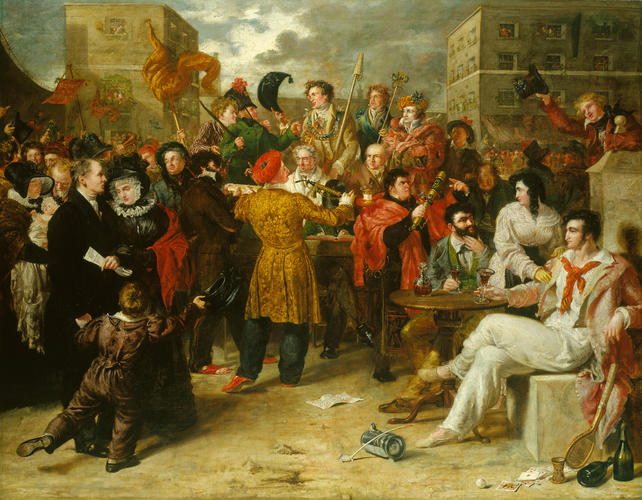The Mock Election 1827
Oil on canvas | 145.0 x 185.6 cm (support, canvas/panel/stretcher external) | RCIN 405824
-
In 1827 Haydon was in King's Bench Prison for debt. While there he observed other inmates putting on a charade election 'headed by self-appointed officials, in order to open a poll for the election of a member to plead for their parliamentary rights' (in reality forfeited by being in prison). Upon his release later in the year he recreated the scene.
A Polling Station in the centre holds the candidates and election officials; a crowd files past to cast their vote. Top centre and in charge sits a careless and witty Irishman, Jonas Murphy, playing Lord High Sheriff, with curtain rings for his gold chain and holes in his jacket elbows. There are three candidates; the first, Joseph Meredith (with red rosette), an Irish hot-head urged on to fisticuffs (and instructed in the art) by a famous pugilist, Henry (Harry) Josiah Holt; the second, the real M. P. Robert Stanton (with blue rosette), draped in a bed-quilt; and the third, the Lord Mayor of King's Gate Prison (with blue and yellow rosette).
The voters are led by the High Constable, a short, red-nosed and menacing man, carrying a mace (with GR on it) and wrapped in a bed-curtain. They are sworn-in (on a piece of deal in place of a Bible) by an engraver, Samuel Holt, playing Head Poll-Clark. Another Poll-Clark, head down, enters names and votes (no secret ballot in those days), while an assessor tries not to laugh. Three feckless inmates are taking the oath; the recently arrived dandy, with a costly pipe, and the broken-down roué, with a cheap cigar and holes in his shoes, make a sort of 'before-and-after' of the profligate life.
On either side in the foreground are two contrasting groups of worthy men brought low by misfortune. The virtuous family man to the left holds a paper, which announces that his debt (£26 10s) has been paid, but the extortionate cost of collecting it (£157 14s) is still owing to the law firm of 'Treachery, Squeeze and Co. of Thieves Inn'. This is what keeps him in a debtors'-prison, with his devoted wife. His eldest son enters into the fun, but the family is in mourning for his dead younger brother, while the weeping nurse holds the most recent arrival. Opposite sits a veteran of the Peninsula War, Major Campbell, imprisoned first for eloping with a ward in chancery and only after for debts incurred while thus prevented from gainful employment. According to Haydon, he is a 'fallen angel' amongst men, with a 'tremendous head' reminiscent of two recently-deceased (and somewhat imperfect) heroes, Byron and Napoleon. He sits aloof, drinking with his companion and girl friend.
The floor is strewn with symbols of fecklessness: a promissory note to a tradesman for a huge sum, which we assume will never be paid; racket and ball; dice and dice-box; cards; bottle and tankard; and the tobacco pipes (here and in the dandy's hand), in which hopes and fortunes go up in smoke.
A high, spiked wall encloses the prison courtyard. In the left background the procession of voters carry placards, reading 'Liberty of the Subject', and 'No Bailiffs'. To the right a Blue-and-Yellow spokesman proposes a toast at an election dinner (a standard form of bribery satirised by Hogarth in his Election Entertainment of 1754). The alternation of sunshine and cloud in the sky expresses the bitter-sweet mood of this prison entertainment.
The painting is a tribute to the British mob, to its resilience and love of Liberty. The former is seen in the resolve of the family man, the stoicism of the soldier, the irrepressible gaiety of the crowd of inmates and the care with which they have tended their window-boxes. The emblem of Liberty in art is a figure with a hat on a stick, looking just like Jonas Murphy, with his staff and strawberry basket. Murphy is the real and emblematic 'Master of Ceremonies' - the spirit of Liberty, which defies even the walls of a prison and embodies the purpose of a real as well as a Mock Election.Provenance
Purchased by George IV in 1828 for 500 guineas; added to the Carlton House inventory dated 1819 (no 623)
-
Medium and techniques
Oil on canvas
Measurements
145.0 x 185.6 cm (support, canvas/panel/stretcher external)
179.0 x 220.0 x 18.0 cm (frame, external)








